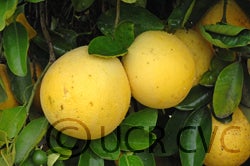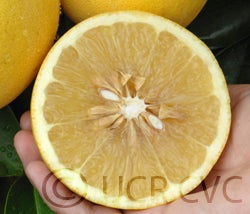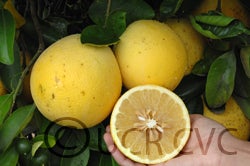Citrus paradisi Macfadyen
CRC 596
PI 539488
Source
Received as budwood from Rubidoux Tract variety block, 1914.
Parentage/origins
Presumed to be an introduction from Florida, 1901.
Rootstocks of accession
Carrizo citrange, C-35 citrange
Season of ripeness at Riverside
February to June
Notes and observations:
1985, EMN: This accession had exocortis, removed by shoot tip grafting. Somewhat different from common seedy white grapefruit in having darker yellow, thicker rind, flesh darker yellow and coarser, flavor sweeter, lacking typical grapefruit flavor and bitterness; more grapefruit-like than orange-like.
5/29/2009, DK, TS, & RRK: Low acid, juicy, seedy. Relatively thin skin, yellow; flesh slightly orange, with distinct orange flavor and aroma. It’s a hybrid.
Description from The Citrus Industry Vol. 1 (1967)
"This California variety produces a medium-small, very seedy fruit that lacks the typical grapefruit flavor and bitterness. In this respect, it closely resembles the Triumph, Mott (Aurantium) and Royal varieties. Of unknown origin, Imperial is presumed to be an introduction from Florida made about 1901 by the R. M. Teague Nurseries of San Dimas, California. It never attained commercial importance and is included here primarily because of its use in the early citrus breeding program at the University of California Citrus Research Center, Riverside."
Availability
Not commercially available in California.
USDA Germplasm Resources Information Network page for Imperial grapefruit



